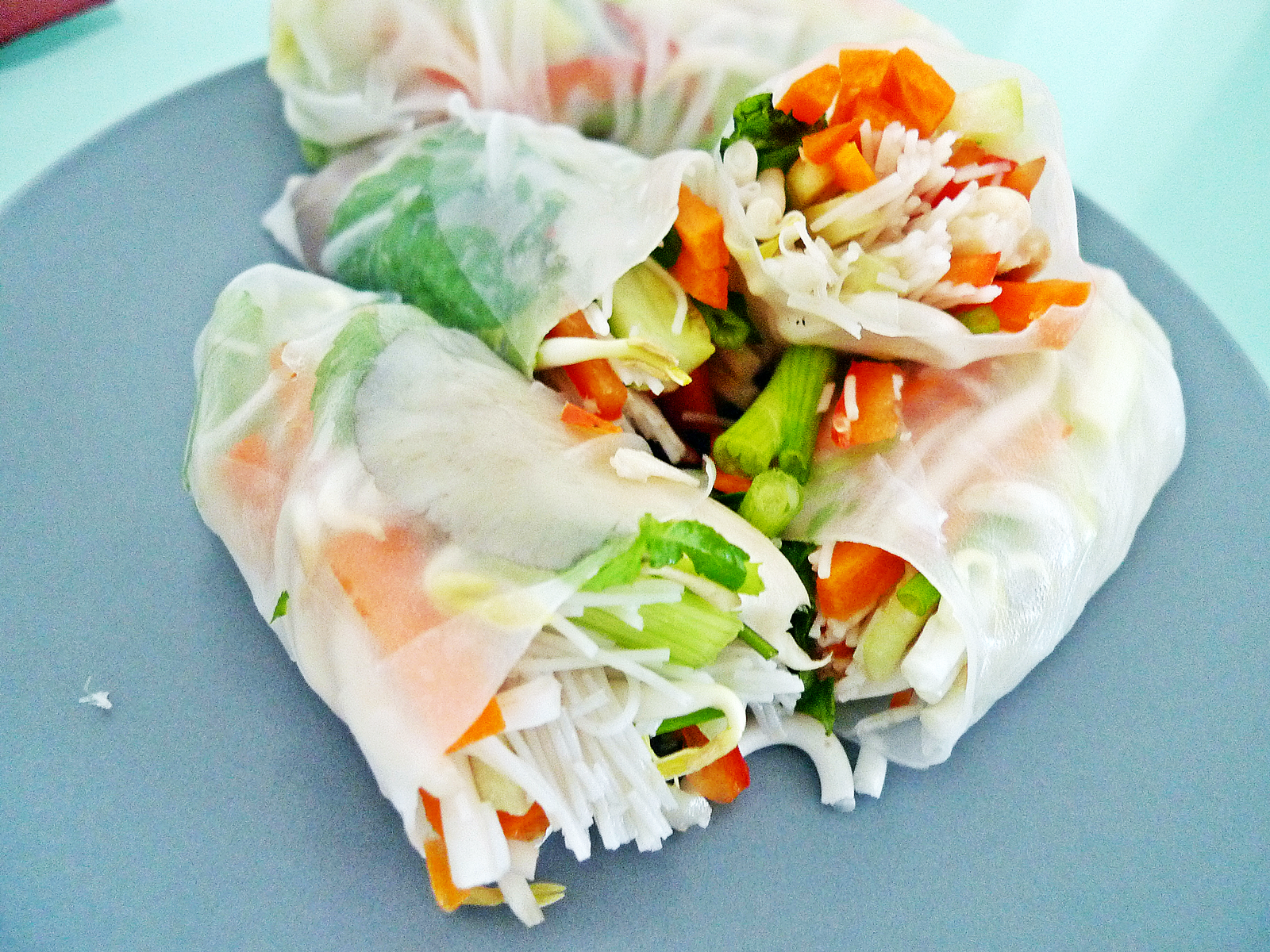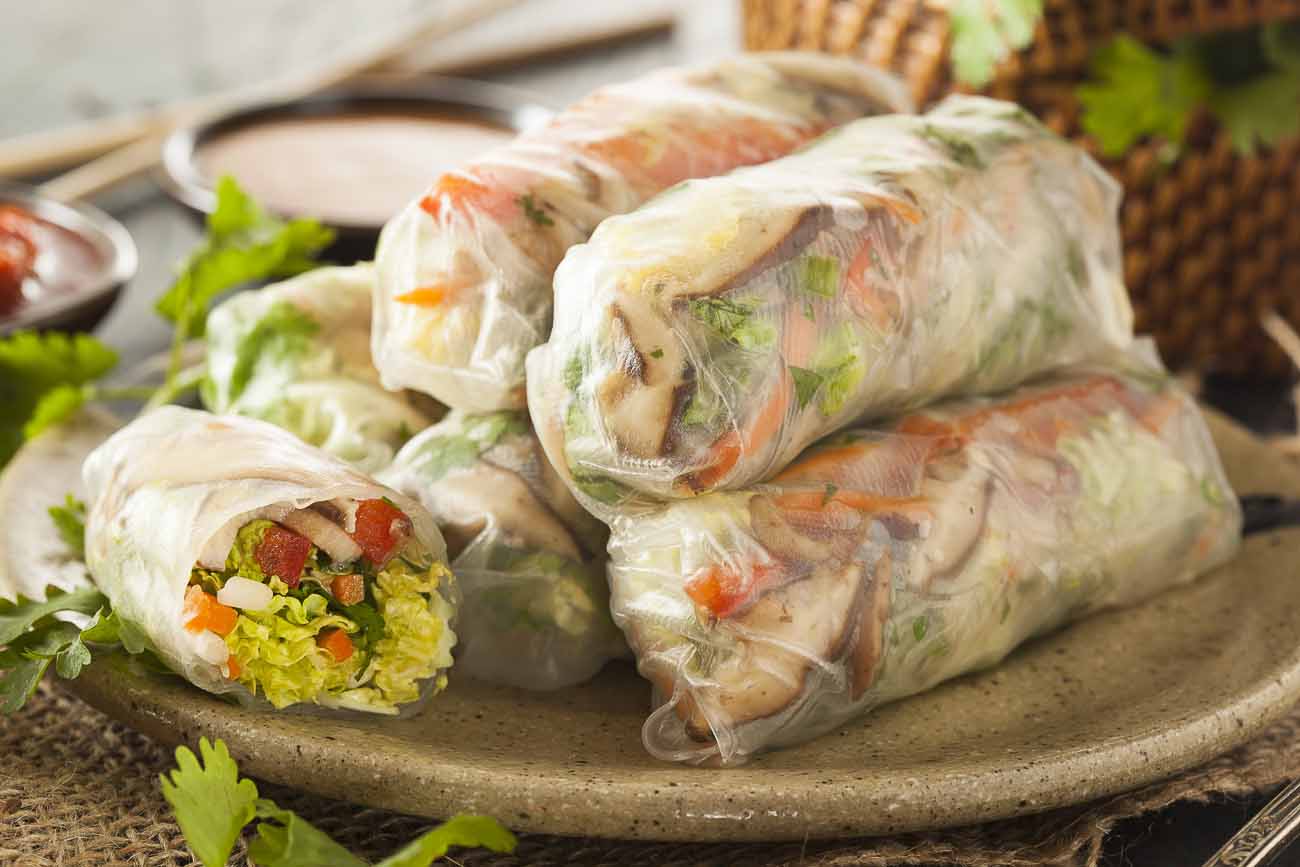Embark on a culinary journey to the heart of Vietnamese cuisine as we delve into the delectable world of rice rolls. These translucent, chewy wonders have captivated taste buds for centuries, showcasing the rich flavors and vibrant culture of Vietnam.
Join us as we explore the history, variations, and health benefits of this beloved dish, providing you with a comprehensive guide to master the art of Vietnamese rice roll making.
From the bustling streets of Hanoi to the serene countryside of the Mekong Delta, rice rolls have woven themselves into the fabric of Vietnamese life. They symbolize celebration, nourishment, and the warmth of family gatherings. Whether served as a quick snack or a main course, these versatile rolls offer a symphony of textures and flavors that will tantalize your senses.
Vietnamese Rice Roll History and Origin

Vietnamese rice rolls, known locally as “Bánh Cuốn,” have a rich history and cultural significance in Vietnam. Their origins can be traced back to the 16th century, during the reign of the Lê Dynasty. It is believed that the dish was first created in the royal kitchens of the imperial palace in Huế, the former capital of Vietnam.
Over the centuries, rice rolls have become an integral part of Vietnamese cuisine and are enjoyed throughout the country. They are typically made from a thin layer of steamed rice batter that is filled with various ingredients, such as minced pork, shrimp, or vegetables.
Rice rolls are often served with a dipping sauce made from fish sauce, vinegar, and sugar.
Regional Variations
There are many different regional variations of rice rolls in Vietnam. In the north, rice rolls are typically made with a thinner batter and are often filled with minced pork and wood ear mushrooms. In the central region, rice rolls are made with a thicker batter and are often filled with shrimp or crab.
In the south, rice rolls are typically made with a combination of rice flour and tapioca flour and are often filled with vegetables.
Ingredients and Variations
The fundamental components of Vietnamese rice rolls are rice flour, water, and salt. The type of rice flour used significantly influences the texture of the rolls.
Types of Rice Flour
There are two primary types of rice flour used in Vietnamese rice rolls:
- Regular rice flour produces rolls with a soft and pliable texture.
- Glutinous rice flour imparts a chewy and sticky texture to the rolls.
Variations of Rice Rolls
Vietnamese rice rolls come in a wide array of variations, each with its own distinct fillings, sauces, and accompaniments.
| Variation | Fillings | Sauce | Accompaniments |
|---|---|---|---|
| Summer Rolls | Shrimp, pork, herbs, vegetables | Peanut sauce | Lettuce, cucumber, mint |
| Grilled Rice Rolls | Pork, shrimp, vegetables | Fish sauce | Pickled carrots and daikon |
| Steamed Rice Rolls | Pork, shrimp, mushrooms | Soy sauce | Green onions, cilantro |
Step-by-Step Recipe s
Creating Vietnamese rice rolls at home is a delightful and rewarding experience. This step-by-step recipe will guide you through the process, ensuring success with every roll.
Preparing the Batter
- In a large bowl, whisk together rice flour, tapioca flour, and salt.
- Gradually add warm water while whisking until a smooth, slightly thick batter forms. It should have a consistency similar to pancake batter.
- Let the batter rest for 30 minutes, covered with plastic wrap.
Steaming the Rolls
- Lightly grease a steamer basket with oil.
- Dip a rice noodle wrapper into the batter, making sure it is completely coated.
- Place the coated wrapper on the steamer basket and steam for 3-4 minutes, or until the wrapper becomes translucent and the edges curl slightly.
- Repeat the process until all the wrappers are steamed.
Troubleshooting Tips
- If the batter is too thick, add a little more warm water.
- If the batter is too thin, add a little more rice flour.
- If the rice rolls stick to the steamer basket, grease it more thoroughly before steaming.
Popular Fillings and Accompaniments
Vietnamese rice rolls are highly versatile and can be filled with a wide array of ingredients. Traditional fillings include pork, shrimp, and a variety of vegetables, such as carrots, bean sprouts, and cucumbers.
These rolls are typically served with a dipping sauce, which can vary in flavor and consistency depending on the region. Common dipping sauces include fish sauce, hoisin sauce, and sweet and sour sauce.
Assembling and Serving
To assemble a rice roll, simply place a few fillings in the center of a rice paper wrapper. Fold the wrapper over the fillings, starting from the bottom and rolling upwards. Serve the rolls with your desired dipping sauce and enjoy.
Nutritional Value and Health Benefits

Vietnamese rice rolls are a low-fat and high-fiber food, making them a healthy choice for people of all ages. They are a good source of carbohydrates, providing energy for the body. Rice rolls are also a good source of protein, which is essential for building and repairing tissues.
Nutritional Value of Vietnamese Rice Rolls
One rice roll (approximately 100 grams) contains the following nutrients:
Calories
100-150
Carbohydrates
20-25 grams
Protein
5-7 grams
Fat
1-2 grams
Fiber
2-3 grams
Health Benefits of Vietnamese Rice Rolls
The low fat and high fiber content of Vietnamese rice rolls make them a healthy choice for people trying to lose weight or maintain a healthy weight. The fiber in rice rolls helps to keep you feeling full and satisfied, which can help to reduce calorie intake.
Rice rolls are also a good source of complex carbohydrates, which are slowly digested and provide sustained energy throughout the day.In addition to their low fat and high fiber content, Vietnamese rice rolls are also a good source of vitamins and minerals, including iron, zinc, and vitamin B6.
These nutrients are essential for good health and can help to boost your immune system, improve your energy levels, and protect your cells from damage.
Tips for Making Healthier Rice Rolls
There are a few simple ways to make Vietnamese rice rolls even healthier. First, use whole-wheat flour instead of white flour. Whole-wheat flour is a good source of fiber and nutrients, and it will give your rice rolls a more hearty texture.
Second, incorporate more vegetables into your rice rolls. Vegetables are a good source of vitamins, minerals, and antioxidants, and they will add flavor and color to your rice rolls.Here are a few tips for making healthier rice rolls:
- Use whole-wheat flour instead of white flour.
- Incorporate more vegetables into your rice rolls.
- Grill or bake your rice rolls instead of frying them.
- Use lean protein sources, such as grilled chicken or tofu.
- Add healthy toppings, such as fresh vegetables, herbs, and low-fat sauces.
By following these tips, you can enjoy all the flavor and health benefits of Vietnamese rice rolls without sacrificing your health.
Cultural Significance and Symbolism
Vietnamese rice rolls, known as bánh cuốn, hold a significant place in Vietnamese cuisine and culture. They represent tradition, family, and community, and are often served during important occasions and celebrations.
Rice rolls are associated with purity and simplicity. Their delicate appearance and mild flavor symbolize the virtues of modesty and humility. In some regions of Vietnam, rice rolls are offered to ancestors during Tet, the Vietnamese Lunar New Year, as a symbol of respect and gratitude.
Stories and Anecdotes
One common story illustrates the cultural significance of rice rolls. During the war against the French, Vietnamese villagers would often hide rice rolls in their clothing to provide sustenance for soldiers. The rolls were small and easy to conceal, making them a valuable and symbolic source of nourishment during times of hardship.
Last Word
As we conclude our exploration of Vietnamese rice rolls, we hope you have gained a deeper appreciation for this culinary treasure. From its humble origins to its diverse regional variations, the rice roll embodies the essence of Vietnamese cuisine. Whether you are a seasoned chef or a novice cook, we encourage you to experiment with different fillings, sauces, and accompaniments to create your own unique rice roll masterpieces.
Remember, the true joy of cooking lies in the journey of discovery and the memories created along the way. Bon appétit!
Answers to Common Questions
What is the key to achieving the perfect texture for rice rolls?
The secret lies in the ratio of rice flour to tapioca flour. A higher proportion of rice flour results in a firmer texture, while more tapioca flour creates a softer, chewier roll.
Can I use other types of flour besides rice flour?
Yes, you can experiment with different flours such as wheat flour or whole-wheat flour. However, these substitutions may alter the texture and flavor of the rice rolls.
How can I make my rice rolls healthier?
Use whole-wheat flour or brown rice flour instead of refined rice flour. Incorporate more vegetables into the fillings, such as carrots, bell peppers, or leafy greens.
What are some creative fillings I can try?
Beyond the traditional fillings of pork, shrimp, and vegetables, you can experiment with tofu, grilled chicken, or even fruits like mango or avocado.
How do I store leftover rice rolls?
Store rice rolls in an airtight container in the refrigerator for up to 3 days. To reheat, steam them for a few minutes until warmed through.
